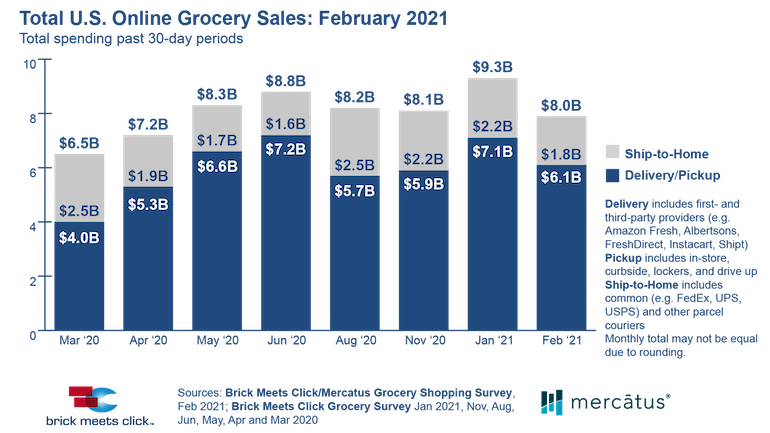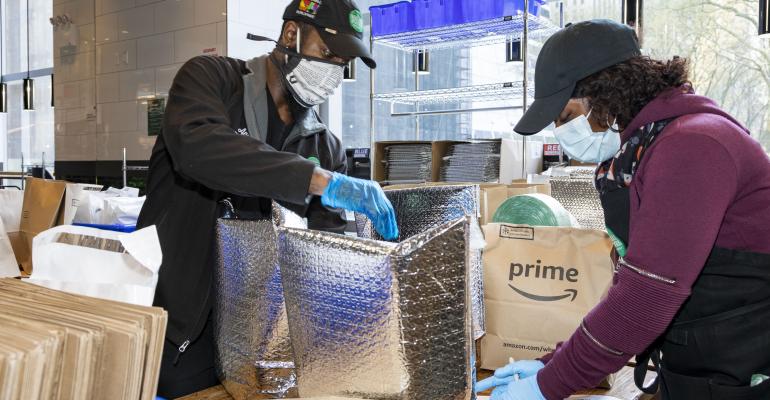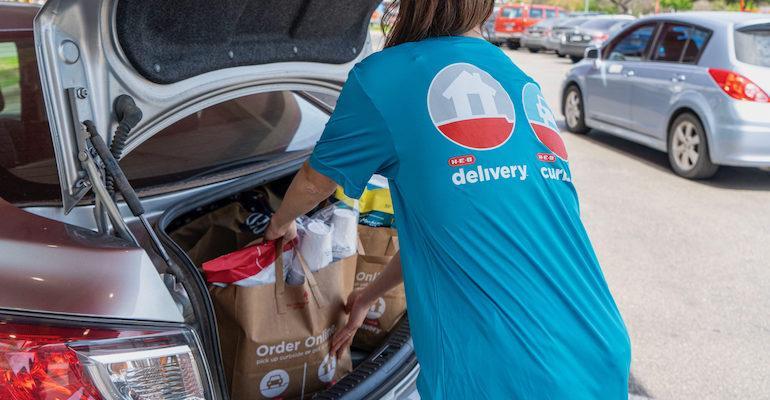U.S. online grocery sales in February fell from a prior-month peak due to a decline in participating households and fewer orders, the latest Brick Meets Click/Mercatus Grocery Shopping Survey found.
For February, online grocery sales totaled $8 billion, down 14% from $9.3 billion in January, Brick Meets Click said Tuesday. The biggest decrease came in ship-to-home sales, which dropped 18.2% to $1.8 billion from $2.2 billion, while delivery and pickup sales slid 14.1% to $6.1 billion from $7.1 billion.
Still, February online grocery sales held at about the same level as in the November and August surveys, at $8.1 billion and $8.2 billion, respectively. What’s more, delivery and pickup sales were higher in February at $6.1 billion versus $5.9 billion in November and $5.7 billion in August.
The delivery/pickup segment remained at about 76% of the online grocery market in February, though pickup sales gained 5% in share from January, Brick Meets Click noted. Pickup represented nearly half of all online grocery sales and about 40% of orders in February.

Fielded Feb. 26 to 28, the Brick Meets Click/Mercatus study polled 1,812 U.S. adults who participated in their household’s grocery shopping and made an online grocery purchase in the previous 30 days.
“February’s overall sales contraction was expected,” according to David Bishop, partner at Brick Meets Click, a Barrington, Ill.-based strategic advisory firm focusing on digital technology’s impact on food sales and marketing. “While January’s sales performance set a record high for online grocery sales, we also saw January’s shopper sentiment related to completing a grocery delivery or pickup order within the next month drop by approximately 10%, and that is what happened, albeit at a slightly higher rate, in February.”
Sales came down mainly because of a smaller base of households buying groceries online. Monthly active users fell 12% to 60.1 million in February from 69.7 million in January. Much of the decrease — more than 40% — came from the over-60 age group, possibly indicating rising confidence and/or personal preferences for in-store shopping as COVID-19 vaccines become more available, Brick Meets Click reported.
February also saw online grocery shoppers place 6% fewer orders, with the average count dipping to 2.7 orders from 2.8 in January. Ship-to-home order frequency decreased 12%, while delivery and pickup declined just 4% month to month. Brick Meets Click noted that households’ expectations and perceptions about the value of online grocery shopping are changing as they become more familiar with the service options.
“Rising vaccination rates, declining new COVID-19 cases and relaxing of various retail restrictions all create headwinds for online grocery shopping,” Bishop explained. “Each of these factors contributes in part to the growing optimism that is leading people to revert to activities that they enjoyed doing before. So, if a person enjoys or prefers to shop in the store, then these changes could be the catalyst for some shopping patterns to revert back. However, these factors alone are less likely to change existing buying behaviors for others who didn’t hold strong positive views about in-store shopping before, especially if they perceive that online shopping is an acceptable alternative.”
Of first-time grocery delivery customers, over 40% said they were extremely or very likely to use that service again.
Consumers’ “likelihood to use a specific service again” stabilized in February, as 58% of households reported being extremely or very likely to place another order with the same delivery or pickup service within the next 30 days. That indicator had plunged over 32 percentage points to 56% in January after a record high in November, with pickup sinking 35 percentage points in that metric.
Overall satisfaction scores were about equal for pickup and delivery in February, but the first-time user scores differed, Brick Meets Click said. More than 40% of first-time delivery service users reported being extremely or very likely to use that service again, whereas repeat intent scores for first-time pickup service were below 30%.
“These scores are concerning, as pickup is only becoming more vital to brick-and-mortar retailers for both strategic and economic reasons,” Bishop added.
On the plus side, average order value (AOV) grew 4% month-to-month in February, driven by the shift toward pickup and delivery, which generate larger orders, Brick Meets Click said. Households spent $82 on average in February for orders received via delivery or pickup, 55% more than ship-to-home purchases delivered by common or contract carriers. At the same time, the AOV climbed almost 11% for ship-to-home orders and just over 1% for delivery/pickup orders from January to February.
“For many regional grocery chains, the online shopping battleground has shifted from delivery to curbside. Lower repeat intent rates for first-time pickup customers puts the spotlight squarely on customer service,” commented Sylvain Perrier, president and CEO of Toronto-based grocery e-commerce provider Mercatus.
“Implementing a frictionless curbside fulfillment experience that wins the customer the first time, every time, will help grocers defend against mass merchants’ low-price advantage,” Perrier noted. “Enhanced pickup services combined with retailer-branded marketing strategies to win back lapsed and lost customers can help increase monthly order frequency and contribute to a healthy contribution margin from online shopping.”





